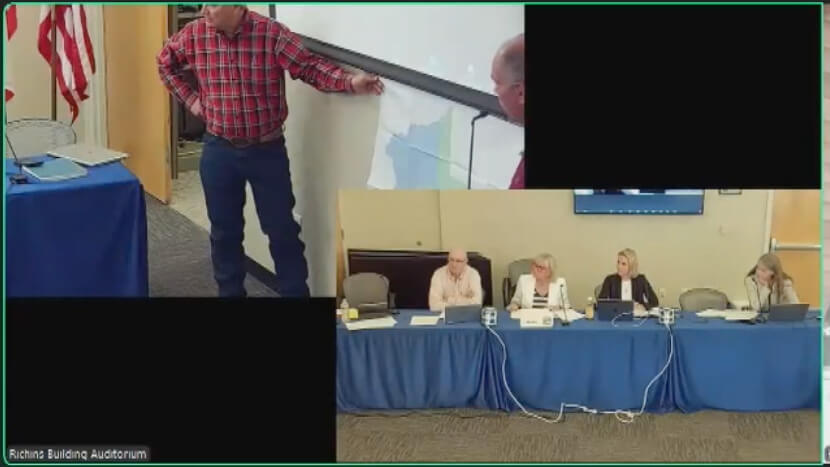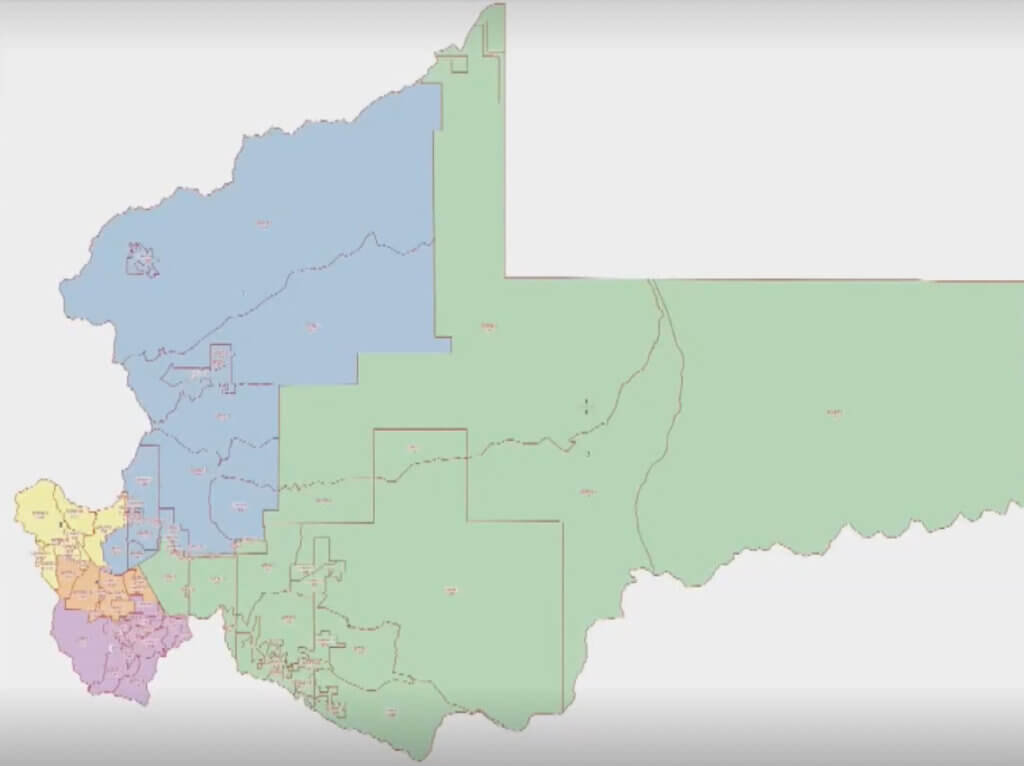Politics
Summit County districting plan approved amid tension, transparency concerns

The District Commission discusses a new map presented at Monday's meeting. Photo: screenshot via Summit County’s arcGIS site
PARK CITY, Utah — What began as a procedural step toward finalizing Summit County’s political map quickly turned contentious Monday night, as Summit County’s Districting Commission approved a revised districting plan despite objections about transparency and process from within its own ranks.
At the heart of the matter was an unforeseen motion by Coalville Mayor Mark Marsh to approve an amended map — one that had not been shared with the public or all commissioners in advance. Commission Chair Malena Stevens, who represents unincorporated Summit County, raised sharp concerns about the lack of discussion and public visibility.
“We can’t just amend it. We have to actually have a discussion about what those precincts look like, where they are, what are the differences? We need to actually pull up the map and go through all of the districts,” Stevens said during the meeting, emphasizing the importance of transparency. “We need to make sure that everything that we vote on, and everything that we are doing is in the public.”
The proposal — co-developed by Marsh and Kamas Mayor Matt McCormick — made only minor tweaks to a map discussed at a June meeting, but the way it was introduced led to a contentious back-and-forth between the commissioners and county officials.
After Marsh made the motion and a short discussion was held to explain the changes to the amended map brought to Monday’s meeting, McCormick then made a motion to “call the question,” to initiate an immediate vote. When Stevens asked for clarification about McCormick’s motion he replied, “Call the question means debate is over.”
Stevens expressed frustration with the tone the meeting had taken and underscored the importance of making sure all members of the commission understood the alterations being proposed.
“Before we’ve had any discussion, to have a prepared, previously prepared motion read, to have another motion that’s put in place saying discussion is over…I don’t understand how that benefits this process or benefits the public’s ability to follow this if we’re not having a robust conversation, as we did in the last meeting,” Stevens said. “Our charge on this body, is to serve the public, and I think communication and transparency are very important when it comes to that.”
Despite the initial objections, after discussing the proposed changes, the commission voted unanimously to forward the plan to the Summit County Council for final review.
A New Mandate from the State
The commission’s work stems from House Bill 356, a controversial state law passed in the final minutes of the 2025 legislative session. It dismantled Summit County’s at-large election system — where voters selected all five County Council members — and instead mandates the creation of five geographical districts, each electing one councilor.

HB 356 also dictated the makeup of the county’s redistricting commission, requiring it to include the seven mayors of Summit County municipalities — Park City, Oakley, Kamas, Francis, Coalville, Henefer, and Hideout — and one representative for unincorporated Summit County, appointed by the County Council. That representative is Stevens, a former councilmember and planning commissioner.
While the Summit County Clerk and members of the County Attorney’s Office provide support, they are non-voting staff.
The legislation requires the commission to submit a district map to the County Council by October 1. The Council must then hold a public hearing within 30 days and vote to approve the map — but cannot revise it, only accept or reject it. As written, the law says the Council “shall approve the district map if the map complies with” population and contiguity requirements.
A Contentious Vote
Monday’s meeting, held at the Richins Building, was fraught from the beginning. Deputy County Attorney Helen Strachan warned the commission that the public Zoom link was incorrect, potentially violating open meetings law. “My suggestion and opinion is that we would do this meeting at another time when it was properly noticed,” she cautioned. But the mayors chose to proceed with the meeting.
Marsh then introduced his motion to adopt an amended map based on general population data from the 2020 census. According to McCormick, the revised version had a tighter deviation — about 3% between the largest and smallest districts — compared to the map the commission discussed at their previous meeting, which used precinct-level data and had a 9% deviation.
Though the changes were modest — including the addition of the mountain resort precinct to the Park City district, the movement of one Pinebrook precinct into the Jeremy Ranch district, the broader Snyderville Basin district being divided in two, and shifting a North Summit precinct into South Summit — Stevens and others initially questioned the rationale for dividing established communities.
“Pinebrook is a tightly knit community,” Stevens said, arguing the area should remain whole. Clerk Eve Furse agreed, noting that dividing such neighborhoods could create confusion and reduce representative effectiveness.
Even some mayors voiced concern about the abrupt process. Oakley Mayor Zane Woolstenhulme said, “It feels like you’re trying to push an agenda here. I’m not quite sure why that would be the case.”
Park City Mayor, Nann Worel, said she was pleased that the alterations resulted in a tighter deviation between districts after Monday’s approval and that Park City proper remained intact. “We needed to stay within a deviation of 10 percent from the largest to the smallest. Overall, I’m very pleased with how we came out, and pleased that Park City is staying as one district, and we added the Mountain Resort precinct to us as well,” she said.
In the en, the largest district on the new map has 8,591 residents and the smallest districts has 8,333 residents.
What Happens Next: Council Assignments in Flux
Now that the map has been approved by the Districting Commission, the Summit County Council is expected to hold a public hearing and final vote on September 3. But as Summit County Manager Shayne Scott explained in an interview, HB 356 does not specify how or when current councilmembers will be assigned to the new districts, nor does it clarify how this will impact the election cycle.
“The bill, as I understand it, is silent on the timing of the seats being assigned to the districts,” Scott said. “It could create real confusion.”
Currently, the law calls for councilmembers to be assigned to districts by random lottery, a method that Scott and others have criticized as potentially chaotic. For example, a sitting councilmember could be assigned to represent a district they don’t live in — disqualifying them from seeking reelection in that district and leaving their home area temporarily unrepresented.
County officials are lobbying for the law to be revised during a legislative special session in September, when HB 356 is expected to be reopened to remove Wasatch County from its requirements. Scott said Summit County is advocating for changes to the lottery provision, hoping to assign councilmembers in a way that makes geographic and representational sense.
As it stands, County Clerk Eve Furse must notify the state of which council seats align with which new districts by November 21 in order to prepare for the next election.
One idea being floated is to assign Councilmember Chris Robinson, who has announced he will not seek reelection, to represent an area currently lacking a representative — such as South Summit — so that voters there can elect someone new in 2025.
“If we could assign members based on where they live and who they represent now, I think we could make it work for everyone,” Scott said.
Broader Political Context
Monday’s meeting underscored political differences between Summit County’s more liberal Snyderville Basin and Park City core, and the more conservative East Side, where several Republican mayors have pushed for the changes brought by HB 356.
The Summit County Democratic Party has called the law an “overreach” by the GOP-controlled Legislature. Party Chair Rory Swensen previously said it is “a solution in search of a problem” and warned that placing redistricting power in the hands of elected mayors opens the door to gerrymandering.
All current Summit County councilmembers are Democrats. A Republican hasn’t held a seat on the council since 2016. East Side mayors, meanwhile, sent a letter to Gov. Spencer Cox earlier this year arguing that districts would provide “fair and equal representation” to their communities.




















